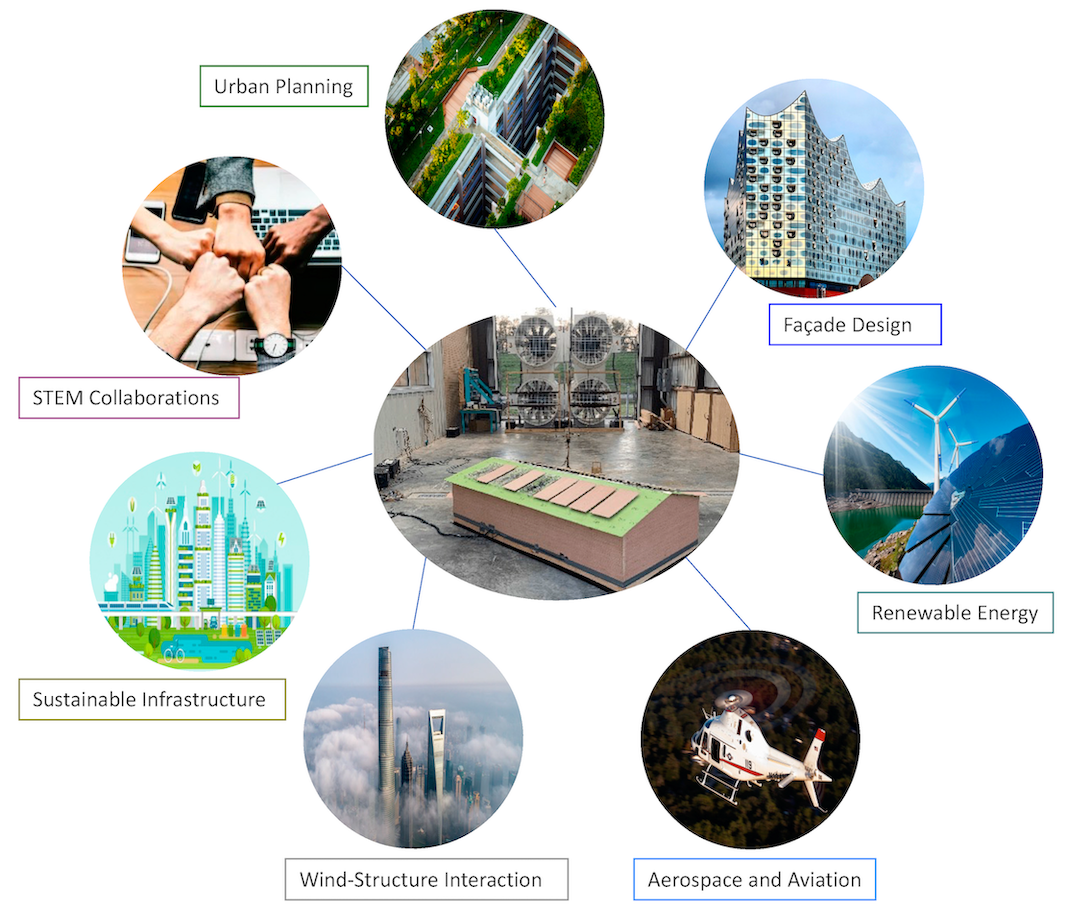🔬 Advancing Wind Engineering: Large and Full-Scale Open-Jet Testing
The Windstorm Impact, Science, and Engineering (WISE) Research Lab at LSU leverages large- and full-scale open-jet testing to address grand challenges in building resilience, sustainability, and structural optimization. This methodology overcomes limitations of conventional wind tunnels, establishing the facility as a Mid-Scale Research Infrastructure designed to revolutionize the field.
I. The Open-Jet Concept: Eliminating Scale Limitations
In the field of aerodynamics, high-speed testing is critical. The open-jet concept is utilized to eliminate potential blockage effects, making it uniquely suitable for large- and full-scale testing. This allows for the determination of aerodynamic loads at high Reynolds numbers without the restrictive need for aggressive scaling requirements.
- Boundary-less Flow: By implementing the concept of flow without boundaries, the facility successfully generates both small- and large-scale turbulence, accurately replicating the atmospheric conditions (Atmospheric Boundary Layer).
- Code Refinement: Groundbreaking studies by Aly et al. (2022) used the LSU Open-Jet Facility to thoroughly investigate velocity-related parameters and statistical quantities of roof pressures on large-scale models.
- Validation: The measured surface pressures closely matched data from the wall-bounded wind tunnel at Tokyo Polytechnic University (TPU) and the established Silsoe full-scale dataset. This confirmed the facility's remarkable ability to accurately replicate mean and peak pressures on low-rise buildings, paving the way for refining design guidelines and evolving code provisions.
II. Unveiling Higher Peak Pressures on High-Rise Cladding
Recent studies have suggested that traditional wall-bounded wind tunnel testing may underestimate critical wind loads. Our research specifically targeted this issue in high-rise buildings, hypothesizing that peak loads on cladding that lead to failure are often underestimated.
🏢 Key Findings on Cladding Design
We conducted a unique large-scale (1:50) experiment, leveraging reduced blockage and the ability to replicate complete velocity spectral content at high Reynolds numbers.
- Hypothesis Confirmed: Our findings confirmed the initial hypothesis. While mean wind pressures on cladding aligned with conventional wind tunnel results, the open-jet consistently generated notably higher peak pressures.
- Real-World Correlation: These higher peak pressures concur with real-world observations of wind-induced damage to cladding, particularly in the upper sections of high-rise structures.
- Aspect Ratio Influence: Observations indicated that the aspect ratio played a crucial role in influencing both mean and peak pressure distributions on the sidewalls, deepening the understanding of cladding performance requirements.
III. WISE Open-Jet Vision: A Paradigm Shift
The LSU WISE open-jet testing approach is positioned to revolutionize wind engineering, fostering resilient and sustainable built environments.
- Impact Areas: The facility's unique capabilities, including complete turbulence at high Reynolds numbers, hold immense promise for critical infrastructure, including:
-
- Low- and high-rise buildings
- Bridges and offshore structures
- Solar panels and wind turbines
- Nature-based solutions for coastal restoration
- Broader Influence: This initiative promises significant economic, societal, and educational impacts across STEM fields, fostering feasible investments within the infrastructure sector, and culminating in the establishment of more robust and sustainable communities.
IV. Core Methodologies and Techniques
Our rigorous testing protocols are built on decades of expertise in fluid mechanics and structural dynamics.
- Pressure Integration Technique (PIT): Using hundreds of pressure taps to measure fluctuating surface pressures and integrate them to predict global structural response (forces and moments).
- Aeroelastic Modeling: Constructing scale models that accurately replicate the mass, stiffness, and damping characteristics of full-scale structures for dynamic response studies.
- Flow Visualization: Employing advanced laser-based systems to visualize and quantify complex flow fields around structures, providing insight into phenomena like separation and reattachment.

Open-Jet Simulations: large open-jet hurricane testing facility at LSU (part of a WRW simulator).

LSU WISE open-jet testing vision: revolutionizing wind engineering to address grand challenges.
Selected Publications
-
Aly, A.M., Khaled, F. (2024), "Open-jet testing: Investigating turbulence and geometric scale effects on surface pressures in the atmospheric boundary layer," Physics of Fluids 36, 125141. https://doi.org/10.1063/5.0231093
-
Aly, A.M. (2023), "Breaking Boundaries in Wind Engineering: LSU WISE Open-Jet Facility Revolutionizes Solar Panel and Building Design," Applied Sciences, 13(23), 12546. https://doi.org/10.3390/app132312546
-
Aly, A.M., Khaled, M.F., Clancy, R. (2022), "Large-Scale Open-Jet Testing: A new frontier in structural wind Engineering," Engineering Structures, 266, 1 September 2022, 114567. https://doi.org/10.1016/j.engstruct.2022.114567
-
Aly, A.M., Chapain, S. (2022), "Large-Scale Open-Jet Testing for Cladding Design in High-Rise Buildings: Higher Peak Pressures Compared to Wind Tunnels," Practice Periodical on Structural Design and Construction, ASCE, 27(2). https://doi.org/10.1061/(ASCE)SC.1943-5576.0000689
-
Aly, A.M., da Fonseca Yousef, N. (2021), "High Reynolds number aerodynamic testing of a roof with parapet," Engineering Structures 234, 1120061. https://doi.org/10.1016/j.engstruct.2021.112006
-
Aly Mousaad Aly, Faiaz Khaled, Hamzeh Gol-Zaroudi. Aerodynamics of Low-Rise Buildings: Challenges and Recent Advances in Experimental and Computational Methods. Aerodynamics, Accepted, InTech, 2020.
-
Aly, A.M., Gol Zaroudi (2017), "Atmospheric Boundary Layer Simulation in a new Open-Jet Facility at LSU: CFD and Experimental Investigations," Measurement, 110, 121-133
-
Gol Zaroudi, H., Aly, A.M. (2017), "Open-jet boundary-layer processes for aerodynamic testing of low-rise buildings," Wind and Structures, 25(3), 233-259. https://doi.org/10.12989/was.2017.25.3.233
-
Aly, A.M. (2014), "Atmospheric boundary-layer simulation for the built environment: past, present and future," Building and Environment, 75, 206-221. https://doi.org/10.1016/j.buildenv.2014.02.004